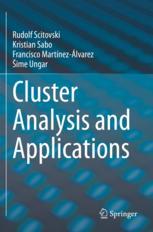图书简介
With the development of Big Data platforms for managing massive amount of data and wide availability of tools for processing these data, the biggest limitation is the lack of trained experts who are qualified to process and interpret the results. This textbook is intended for graduate students and experts using methods of cluster analysis and applications in various fields.With clear explanations of ideas and precise definitions of notions, accompanied by numerous examples and exercises together with Mathematica programs and modules, Cluster Analysis and Applications is meant for students and researchers in various disciplines, working in data analysis or data science.
1.- Introduction. 2 Representatives.- 2.1 Representative of data sets with one feature. 2.1.1. Best LS-representative.- 2.1.2 Best `1-representative.- 2.1.3 Best representative of weighted data.- 2.1.4 Bregman divergences.- 2.2 Representative of data sets with two features.- 2.2.1 Fermat–Torricelli–Weber problem.- 2.2.2 Centroid of a set in the plane.- 2.2.3 Median of a set in the plane.- 2.2.4 Geometric median of a set in the plane.- 2.3 Representative of data sets with several features.- 2.3.1 Representative of weighted data.- 2.4 Representative of periodic data.- 2.4.1 Representative of data on the unit circle.- 2.4.2 Burn diagram.- 3 Data clustering.- 3.1 Optimal k-partition.- 3.1.1 Minimal distance principle and Voronoi diagram.- 3.1.2 k-means algorithm.- 3.2 Clustering data with one feature.- 3.2.1 Application of the LS-distance-like function.- 3.2.2 The dual problem.- 3.2.3 Least absolute deviation principle.- 3.2.4 Clustering weighted data.- 3.3 Clustering data with two or several features.- 3.3.1 Least squares principle.- 3.3.2 The dual problem.- 3.3.3 Least absolute deviation principle.- 3.4 Objective function F(c1, . . . , ck) = Pm i=1 min 1≤j≤k d(cj , ai).- 4 Searching for an optimal partition.- 4.1 Solving the global optimization problem directly.- 4.2 k-means algorithm II.- 4.2.1 Objective function F using the membership matrix.- 4.2.2 Coordinate Descent Algorithms.- 4.2.3 Standard k-means algorithm.- 4.2.4 k-means algorithm with multiple activations.- 4.3 Incremental algorithm.- 4.4 Hierarchical algorithms.- 4.4.1 Introduction and motivation.- 4.4.2 Applying the Least Squares Principle. 4.5 DBSCAN method.- 4.5.1 Parameters MinPts and 97 4.5.2 DBSCAN algorithm.- 4.5.3 Numerical examples.- 5 Indexes.- 5.1 Choosing a partition with the most appropriate number of clusters.- 5.1.1 Calinski–Harabasz index.- 5.1.2 Davies–Bouldin index.- 5.1.3 Silhouette Width Criterion.- 5.1.4 Dunn index.- 5.2 Comparing two partitions.- 5.2.1 Rand index of two partitions.- 5.2.2 Application of the Hausdorff distance.- 6 Mahalanobis data clustering.- 6.1 Total least squares line in the plane. 6.2 Mahalanobis distance-like function in the plane.- 6.3 Mahalanobis distance induced by a set in the plane.- 6.3.1 Mahalanobis distance induced by a set of points in R n.- 6.4 Methods to search for optimal partition with ellipsoidal clusters.- 6.4.1 Mahalanobis k-means algorithm 139 CONTENTS v.- 6.4.2 Mahalanobis incremental algorithm.- 6.4.3 Expectation Maximization algorithm for Gaussian mixtures.- 6.4.4 Expectation Maximization algorithm for normalized Gaussian mixtures and Mahalanobis k-means algorithm.- 6.5 Choosing partition with the most appropriate number of ellipsoidal clusters.- 7 Fuzzy clustering problem.- 7.1 Determining membership functions and centers.- 7.1.1 Membership functions. 7.1.2 Centers.- 7.2 Searching for an optimal fuzzy partition with spherical clusters.- 7.2.1 Fuzzy c-means algorithm.- 7.2.2 Fuzzy incremental clustering algorithm (FInc).- 7.2.3 Choosing the most appropriate number of clusters.- 7.3 Methods to search for an optimal fuzzy partition with ellipsoidal clusters.- 7.3.1 Gustafson–Kessel c-means algorithm.- 7.3.2 Mahalanobis fuzzy incremental algorithm (MFInc).- 7.3.3 Choosing the most appropriate number of clusters.- 7.4 Fuzzy variant of the Rand index.- 7.4.1 Applications.- 8 Applications.- 8.1 Multiple geometric objects detection problem and applications.- 8.1.1 Multiple circles detection problem.- 8.1.2 Multiple ellipses detection problem.- 8.1.3 Multiple generalized circles detection problem.- 8.1.4 Multiple lines detection problem.- 8.1.5 Solving MGOD-problem by using the RANSAC method.- 8.2 Determining seismic zones in an area.- 8.2.1 Searching for seismic zones.- 8.2.2 The absolute time of an event.- 8.2.3 The analysis of earthquakes in one zone.- 8.2.4 The wider area of the Iberian Peninsula.- 8.2.5
Trade Policy 买家须知
- 关于产品:
- ● 正版保障:本网站隶属于中国国际图书贸易集团公司,确保所有图书都是100%正版。
- ● 环保纸张:进口图书大多使用的都是环保轻型张,颜色偏黄,重量比较轻。
- ● 毛边版:即书翻页的地方,故意做成了参差不齐的样子,一般为精装版,更具收藏价值。
关于退换货:- 由于预订产品的特殊性,采购订单正式发订后,买方不得无故取消全部或部分产品的订购。
- 由于进口图书的特殊性,发生以下情况的,请直接拒收货物,由快递返回:
- ● 外包装破损/发错货/少发货/图书外观破损/图书配件不全(例如:光盘等)
并请在工作日通过电话400-008-1110联系我们。
- 签收后,如发生以下情况,请在签收后的5个工作日内联系客服办理退换货:
- ● 缺页/错页/错印/脱线
关于发货时间:- 一般情况下:
- ●【现货】 下单后48小时内由北京(库房)发出快递。
- ●【预订】【预售】下单后国外发货,到货时间预计5-8周左右,店铺默认中通快递,如需顺丰快递邮费到付。
- ● 需要开具发票的客户,发货时间可能在上述基础上再延后1-2个工作日(紧急发票需求,请联系010-68433105/3213);
- ● 如遇其他特殊原因,对发货时间有影响的,我们会第一时间在网站公告,敬请留意。
关于到货时间:- 由于进口图书入境入库后,都是委托第三方快递发货,所以我们只能保证在规定时间内发出,但无法为您保证确切的到货时间。
- ● 主要城市一般2-4天
- ● 偏远地区一般4-7天
关于接听咨询电话的时间:- 010-68433105/3213正常接听咨询电话的时间为:周一至周五上午8:30~下午5:00,周六、日及法定节假日休息,将无法接听来电,敬请谅解。
- 其它时间您也可以通过邮件联系我们:customer@readgo.cn,工作日会优先处理。
关于快递:- ● 已付款订单:主要由中通、宅急送负责派送,订单进度查询请拨打010-68433105/3213。
本书暂无推荐
本书暂无推荐















